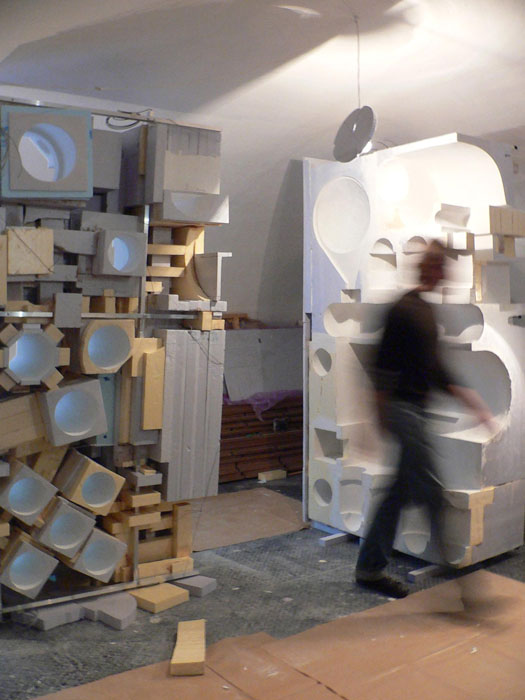TALKS about architecture offers a podium to emerging European architects who approach architecture primarily as an artistic discipline that derives its social relevance from its poetic and spatial qualities. The new series of lectures kicks off on 23 June with Andrea Zanderigo of the Italian architecture office Baukuh. ArchiNed asked him five questions.

Andrea Zanderigo’s desk at Baukuh’s office: 1 – Sostegno e Adornamento. Saggi sull’architettura del Rinascimento: disegno, ordini, magnificenza by Christof Thoenes (1998). ‘A rough translation of the title Support and decoration. Essays on the architecture of the Renaissance. Drawing, orders, magnificence.’ 2 – Giorgio Grassi. I progetti, le opere e gli scritti, edited by Giovanna Crespi and Simona Pierini. ‘A quite standard monography on Grassi.’ 3 – 900 Km Nile City. A Strategic Design Proposal for a Rural Metropolis. ‘The in-house publication of our project on the Nile Valley, made together with Atelier Kempe Thill, Grau, Lola, Deerns, Giovanna Silva, Stefano Graziani, Bas Princen.’ 4 – Bag from the architects association of Milan. 5 – A tender brief from the politecnico of Milan for teaching positions. 6 – Koolhaas Tangram, ed. Pedro Baía, Circo de Ideias (2014). 7 – ‘A relatively shitty book on the renovation of the Milano Porta Nuova area, called Milano Porta Nuova. Italy rises. Our project House of Memory is published in the book.’ 8 – ‘The little objects do not represent anything in particular. We like to collect little architectures, sculptures and nice, weird objects. Most of them are souvenirs and scale reproductions of objects from ancestral cultures. The really funny one is the transparent pyramid with the Ka’ba inside. The objects are everywhere in the office.’ 9 – ‘The two bowls have no function. I don’t even know where they come from…one day they were there.’
0 – What does the name Baukuh mean or refers to?
It does not really mean anything, apart from what it literally means, in German. You need a collective name if you start an office with eight partners, as we did twelve years ago. And we like cows, their supposed ignorance, their stubbornness.
1 – What is architecture?
To quote Giorgio Grassi, architecture is the ‘architectures’, meaning that architecture is simply the countless accumulation of buildings, projects, drawings and so forth. This informal accumulation of formal knowledge constitutes an ever-growing corpus on which every subsequent architectural decision is necessarily (if not always consciously) based. The reference here is to the English legal system and its accumulation of cases as precedents/ancestors. As such, architecture is an eminently collective knowledge, whose access keys are totally public. As a result, producing architecture is the – rational – act of selecting the right precedents for this extremely generous shared knowledge.
2 – What can architecture do?
Very little, probably. But this very little that architecture can do is nevertheless of extreme importance. Every architectural operation is by definition a public act and not only because it is based on shared knowledge. There is no architecture without city, no architecture outside of the even covered field. Architecture produces the city while simultaneously belonging to the city (The Architecture of the City). Evidently the city is the product of a collective effort, the output of a multitude. As such, even the most private architecture is necessarily dealing with the public, enabling its enactment and ultimately co-shaping it.
3 – Besides your ‘normal’ architectural practice, you publish the magazine San Rocco. What was the reason to publish a paper magazine?
We started San Rocco because we felt we had something to say, or at least we had the presumption of having something to say. We needed a suitable stage which we couldn’t find in the panorama of publications, universities, institutions or blogs which were around us at the time. The decision to go for a paper publication – besides the fetishist aspect of the publication as an object – was simply related to the aspiration for a certain weight, a certain permanence for the maybe incongruous set of thoughts we wanted to express. No Snapchat simultaneity and evanescence in San Rocco.
4 – How would you position Baukuh in a European architectural movement that can be characterised by references made to ‘obscure architects’ from the last century (quote from a Dutch critic), the special interest paid to the end elevation, to ornamentation, and the way brick is used, and that has a strong regional focus?
It’s really not my task to position Baukuh in the European architectural movement. The only thing I can say is that Baukuh is part of a generation of architects which is evidently European, if not wider. A generation which, despite obvious differences, is tentatively sharing a common discourse on architecture. San Rocco is one of the portraits of this generation. So I strongly reject the idea of it being regionally focused.

Baukuh’s office: the model is their entry for the competition held in 2008 for the Italian pavilion at the Expo 2010 in Shanghai